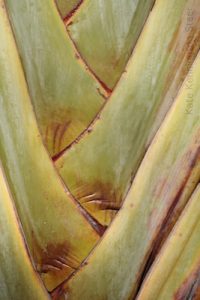Whenever I reflect on the metaphors of pilgrimage and journeying, it isn’t long before I remember a favourite tree that is one of the prize specimens in the glass house at the Royal Horticultural Society’s gardens at Wisley, which are a favourite haunt for me and my mum. Ravenala madagascariensis is a tree from Madagascar that is commonly known as the ‘Traveller’s Tree’. The legends go that it’s called this either because the palm like leaves hold water that could be drunk in an emergency, or because the fan shape in which the leaves are held grows on an east-west axis and could potentially be used as a compass. (Neither of these should be put to the test!)
I love this tree because it flourishes in adversity: it is an amalgam of different colours and textures, and as I have watched this Wisley specimen grow over time, the colours and shapes shift, merge and split. I spend long periods sitting in front of it holding a camera, seeing more and more intricacy as it matures. The name of this tree is also makes me remember a BBC Radio Four programme I sometimes catch which is called ‘Traveller’s Tree’ based on the folk tradition that travellers in Africa and South America pin advice for fellow travellers to trees.
As I sit in front of photographs of ‘my’ tree, I am reminded of how dependent I am on the need to travel my faith pilgrimage in the company of others, and how greatly I need to heed their fellow direction and advice along roads they have already travelled ahead of me. Being part of a community of pilgrims is vital for me since I spend much of my life alone, housebound or in bed, and can count the number of times I have got to church in the last four years on the fingers of one hand. The tension between travelling alone and in company becomes particularly evident when I am struggling with periods of recurring depression. At these times the lie that I have been abandoned by God is very loud in my head indeed. But it is is precisely in these ‘desert’ places that I need to remember the lesson of the Traveller’s Tree: God is present; God has provided and will continue to provide (often in creative, unlooked for and unusual ways); God has given me guides, teachers and companions along the way to accompany me in my lostness.
I wrote for this blog last year about ‘travelling whilst staying still’, and I realise a year on how pertinent that phrase remains for me. I keep returning to the Benedictine concept of ‘Statio’, and the importance of being rooted and grounded in one place. My bed can become the holy reminder that this journey I am travelling is a pilgrimage to the Now, to the Source of all Being, who is found not in a certain place my wheelchair can’t get to, nor in a certain religious practice my personality doesn’t warm to, but is found, by infinite Grace, in this moment where I already am.
I find myself on a pilgrimage of Presence. I am following the invitation of the Host to surrender my struggles in a series of infinite pauses along the Way.
I know this invitation to ‘be’ first rather than ‘do’ first is a vital one for me, a vital lesson (literally life-giving) in combatting the overachiever, the boom/bust artist, the ambitious, competitive perfectionist I am. So it is unsurprising I frequently fail. I pick up the heavy baggage again that I have only just put down. I don’t listen to the knowledge I have been given inside me. I don’t concentrate on the words of those guides who have made maps for me. Nor do I pay enough attention to the wondrous signs of the world right in front of my eyes. But eventually Grace prompts me to come to my senses, to realise I’ve been drifting, and to set off with intention once more towards my God in the direction that ancient teacher Wisdom has given me.
Along her path there is much pleasure,
and her path goes through places of peace.
She is a tree of life for those who bring her inside,
those who hold her firmly inside are called happy.
(from In Praise of Sophia, Proverbs 3.11-20, translated by Aaron Blum)
I am thankful for those places of peace that I find. This Godspace/Mustard Seed community is one. The Ravenala madagascariensis is another. And I remind myself again of one last fact about this tree: it is fitting that it is defined as a member of the ‘bird of paradise’ family.
In the shade of the Traveller’s Tree you can call me happy.





6 comments
Kate, in may ways you could be penning my own faith journey and life story. Especially with these words: ” Being part of a community of pilgrims is vital for me since I spend much of my life alone, housebound or in bed.” How I value reading posts such as this and travelling with like-minded pilgrims “on a pilgrimage of Presence.” You see and sense so much in your stillness and my soul sinks grateful into these words. Thank you, Kate, for being beautifully transparent about your struggles and what is shaping the acceptance and overcoming of them. Blessings of health and strength to you.
Love this, Kate, so eloquent and humble. It is an honour to be journeying with you (albeit in Statio). Your words and photographs always reveal new and hidden truths. Keren x
Thank you so much as ever Keren for your encouragement. Journeying in Statio together with you is such a privelege and gives me deep succour. Thank you.
Bless you Kate! This is beautiful. Your struggles have certainly made you strong. Thank you for sharing.
Thank you so much for your encouragement and your blessing Nancy.
Dear Joy, thank you for your encouragement and your blessing. I’ve been reflecting a lot on that phrase “Pilgrimage of Presence’ since I wrote this post, and the more I delve the richer an image it seems to become so I’m so glad it resonated in you too. And I am honoured to have such precious company as yours alongside me for the journey. Thank you.